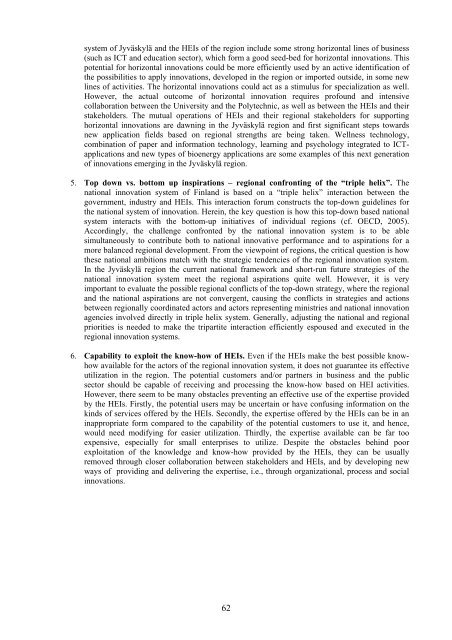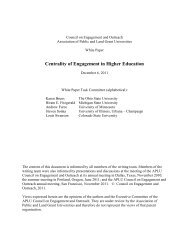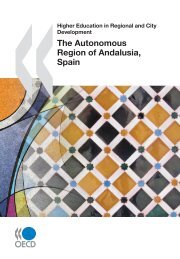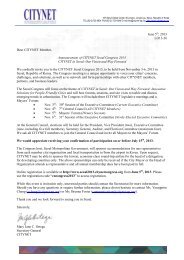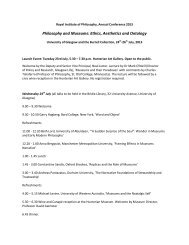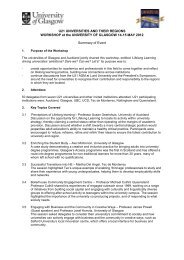Finland - Jyvaskyla Region - Final Self-Evaluation Report.pdf
Finland - Jyvaskyla Region - Final Self-Evaluation Report.pdf
Finland - Jyvaskyla Region - Final Self-Evaluation Report.pdf
You also want an ePaper? Increase the reach of your titles
YUMPU automatically turns print PDFs into web optimized ePapers that Google loves.
system of Jyväskylä and the HEIs of the region include some strong horizontal lines of business(such as ICT and education sector), which form a good seed-bed for horizontal innovations. Thispotential for horizontal innovations could be more efficiently used by an active identification ofthe possibilities to apply innovations, developed in the region or imported outside, in some newlines of activities. The horizontal innovations could act as a stimulus for specialization as well.However, the actual outcome of horizontal innovation requires profound and intensivecollaboration between the University and the Polytechnic, as well as between the HEIs and theirstakeholders. The mutual operations of HEIs and their regional stakeholders for supportinghorizontal innovations are dawning in the Jyväskylä region and first significant steps towardsnew application fields based on regional strengths are being taken. Wellness technology,combination of paper and information technology, learning and psychology integrated to ICTapplicationsand new types of bioenergy applications are some examples of this next generationof innovations emerging in the Jyväskylä region.5. Top down vs. bottom up inspirations – regional confronting of the “triple helix”. Thenational innovation system of <strong>Finland</strong> is based on a “triple helix” interaction between thegovernment, industry and HEIs. This interaction forum constructs the top-down guidelines forthe national system of innovation. Herein, the key question is how this top-down based nationalsystem interacts with the bottom-up initiatives of individual regions (cf. OECD, 2005).Accordingly, the challenge confronted by the national innovation system is to be ablesimultaneously to contribute both to national innovative performance and to aspirations for amore balanced regional development. From the viewpoint of regions, the critical question is howthese national ambitions match with the strategic tendencies of the regional innovation system.In the Jyväskylä region the current national framework and short-run future strategies of thenational innovation system meet the regional aspirations quite well. However, it is veryimportant to evaluate the possible regional conflicts of the top-down strategy, where the regionaland the national aspirations are not convergent, causing the conflicts in strategies and actionsbetween regionally coordinated actors and actors representing ministries and national innovationagencies involved directly in triple helix system. Generally, adjusting the national and regionalpriorities is needed to make the tripartite interaction efficiently espoused and executed in theregional innovation systems.6. Capability to exploit the know-how of HEIs. Even if the HEIs make the best possible knowhowavailable for the actors of the regional innovation system, it does not guarantee its effectiveutilization in the region. The potential customers and/or partners in business and the publicsector should be capable of receiving and processing the know-how based on HEI activities.However, there seem to be many obstacles preventing an effective use of the expertise providedby the HEIs. Firstly, the potential users may be uncertain or have confusing information on thekinds of services offered by the HEIs. Secondly, the expertise offered by the HEIs can be in aninappropriate form compared to the capability of the potential customers to use it, and hence,would need modifying for easier utilization. Thirdly, the expertise available can be far tooexpensive, especially for small enterprises to utilize. Despite the obstacles behind poorexploitation of the knowledge and know-how provided by the HEIs, they can be usuallyremoved through closer collaboration between stakeholders and HEIs, and by developing newways of providing and delivering the expertise, i.e., through organizational, process and socialinnovations.62


